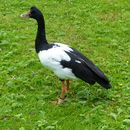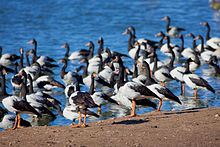en
names in breadcrumbs


Magpie geese communicate vocally with loud "honks." These geese may shake their wings when feeling threatened or after antagonistic encounters.
Communication Channels: visual ; acoustic
Perception Channels: visual ; tactile ; acoustic ; chemical
In Australia, magpie geese are listed as "secure" (meaning "of least concern"), but each territory also has its own status. Magpie geese are listed as "endangered" in Victoria and South Australia, "secure" in Northern Territory, Queensland and Western Australia, and "vulnerable" in New South Wales. They are considered "least concern" by the IUCN red list.
US Migratory Bird Act: no special status
US Federal List: no special status
CITES: no special status
State of Michigan List: no special status
IUCN Red List of Threatened Species: least concern
There are no known adverse effects of magpie geese on humans.
Humans hunt magpie geese for sport and for food.
Positive Impacts: food ; body parts are source of valuable material
Magpie geese compete for resources with other seed-eaters in wetlands and act as prey for predators in the same areas.
Magpie geese mainly eat swamp grass seeds, blades of dry grasses, and bulbs of spike-rush. They also eat large quantities of wild rice. These geese feed in large, noisy flocks. Parents help their chicks eat by bending down tall grass towards the nest so the chicks can eat the seeds from it. Although they are mainly herbivores, they incidentally ingest occasional small invertebrates. During the dry season, magpie geese must rely on roots and bulbs as their primary source of food. During the wet season, they can switch to grass as their main food.
Animal Foods: insects
Plant Foods: leaves; roots and tubers; seeds, grains, and nuts
Primary Diet: herbivore (Granivore )
Magpie geese are found only in their native Australia and the neighboring island of New Guinea, primarily in Pacific coastal areas.
Biogeographic Regions: australian (Native )
Most magpie geese are found in wet grasslands, swamps, and other marshlands along the coast and rarely stray inland.
Habitat Regions: temperate ; terrestrial
Aquatic Biomes: coastal
Wetlands: marsh ; swamp
Other Habitat Features: riparian
Magpie geese can live to be over 32 years in the wild.
Typical lifespan
Status: wild: 32 (high) years.
Magpie geese are black on the head, neck, tail, and wings. The rest of the body is white, with orange feet and legs. Magpie geese have only partially webbed feet and the head has a fairly obvious "knob" on it. Juveniles lack this "knob" and the white areas on their bodies are more gray. Females tend to be smaller than males. Their body mass varies between 2 and 3 kg and their length ranges from 70 to 90 cm. The average wingspan is 1.5 meters.
Range mass: 2 to 3 kg.
Range length: 70 to 90 cm.
Average wingspan: 1.5 m.
Other Physical Features: endothermic ; homoiothermic; bilateral symmetry
Sexual Dimorphism: male larger
Eggs and hatchlings are heavily preyed on by birds of prey, dingoes, snakes, and other small, terrestrial predators. Adult magpie geese are rarely preyed on, although they are hunted by humans.
Known Predators:
Magpie geese sometimes breed in pairs, but they usually breed in groups of three. Each group of three consists of a male and two females. In each trio, the two females are usually related to each other. Magpie geese breed seasonally. Information on mate attracting and mate guarding could not be found.
Mating System: polygynous ; cooperative breeder
Magpie geese clutch size is between 3 and 8 eggs. They breed seasonally at the end of the wet season (February-June) in the floodplains that they live in. The incubation period varies from 24-35 days and fledgling occurs after about 3 months. To feed their young while they are still in the nests, the parents can bend nearby tall grass so the chicks can eat the seeds. All parents share the responsibility of incubating the eggs and caring for the young. Young are cared for by the parents until the following wet season. Average mass at hatching is 104.2 grams. Sexual maturity occurs at approximately 2 years of age.
Breeding interval: Magpie geese breed once yearly.
Breeding season: Breeding occurs from February to June.
Range eggs per season: 3 to 8.
Average eggs per season: 7.
Range time to hatching: 24 to 35 days.
Average fledging age: 3 months.
Average age at sexual or reproductive maturity (female): 2 years.
Average age at sexual or reproductive maturity (male): 2 years.
Key Reproductive Features: iteroparous ; seasonal breeding ; gonochoric/gonochoristic/dioecious (sexes separate); sexual ; oviparous
Both parents (and the second female when in trios) care for the young. They take turns incubating the eggs as well as providing food and protection for the hatched young.
Parental Investment: precocial ; pre-fertilization (Provisioning, Protecting: Female); pre-hatching/birth (Provisioning: Female, Protecting: Male, Female); pre-weaning/fledging (Provisioning: Male, Female, Protecting: Male, Female); pre-independence (Provisioning: Male, Female, Protecting: Male, Female)
The magpie goose (Anseranas semipalmata) is the sole living representative species of the family Anseranatidae. This common waterbird is found in northern Australia and southern New Guinea.[2] As the species is prone to wandering, especially when not breeding, it is sometimes recorded outside its core range.[2] The species was once also widespread in southern Australia but disappeared from there largely due to the drainage of the wetlands where the birds once bred. Due to their importance to Aboriginal people as a seasonal food source,[3] as subjects of recreational hunting,[4] and as a tourist attraction, their expansive and stable presence in northern Australia has been "ensured [by] protective management".[5]
Magpie geese are unmistakable birds with their black and white plumage and yellowish legs. The feet are only partially webbed, and the magpie goose feeds on vegetable matter in the water, as well as on land. Males are larger than females. Unlike true geese, their molt is gradual, so no flightless periods result. Their voice is a loud honking.
This species is placed in the order Anseriformes, having the characteristic bill structure, but is considered to be distinct from the other species in this taxon. The related and extant families, Anhimidae (screamers) and Anatidae (ducks, geese, and swans), contain all the other taxa. The magpie goose is contained in the genus Anseranas and family Anseranatidae, which are monotypic now.[6]
A cladistic study of the morphology of waterfowl found that the magpie goose was an early and distinctive offshoot, diverging after screamers and before all other ducks, geese, and swans.[7]
This family is quite old, a living fossil, having apparently diverged before the Cretaceous–Paleogene extinction event — the relative Vegavis iaai lived some 68-67 million years ago. The fossil record is limited, nonetheless. The enigmatic genus Anatalavis (Hornerstown Late Cretaceous or Early Paleocene of New Jersey, USA - London Clay Early Eocene of Walton-on-the-Naze, England) is sometimes considered to be the earliest known. Other Paleogene birds sometimes considered magpie-geese are the genera Geranopsis from the Hordwell Formation Late Eocene to the Early Oligocene of England and Anserpica from the Late Oligocene of Billy-Créchy (France).[8]
The earliest known member of the group in Australia is Eoanseranas represented by fossils found in the late Oligocene Carl Creek Limestone of Queensland.[9] Additional fossils from North America and Europe suggest that the family was spread across the globe during the late Paleogene period.[10] The Australian distribution of the living species ties in well with the presumed Gondwanan origin of Anseriformes, but Northern Hemisphere fossils are puzzling. Perhaps the magpie geese were one of the dominant groups of Paleogene waterfowl, only to become largely extinct later.


The magpie goose is found in a variety of open wetland areas such as floodplains and swamps, where they wade and swim. They eat mostly vegetation such as dry grass blades, grass seeds, spike rush bulbs and wild rice.[11]
It is fairly sedentary apart from some movement during the dry season. They are colonial breeders and are gregarious outside of the breeding season when they can form large and noisy flocks of up to a few thousand individuals. Its nest is on the ground (also in trees 5 m or more high), and a typical clutch is 5-14 eggs. Some males mate with two females, all of which raise the young, unlike some other polygamous birds. This may be beneficial when predation of young is high as chicks raised by trios are more likely to survive.
This species is plentiful across its range, although this is significantly reduced in comparison to the range at time of European settlement. The range once extended as far south as the Coorong and the wetlands of the southeast of South Australia and Western Victoria. For Australia as a whole, it is not threatened and has a controlled hunting season when numbers are large. However, most of the southern populations were extirpated in the mid-20th century by overhunting and habitat destruction. The species has been subject to reintroduction projects such as Bool Lagoon between Penola and Naracoorte. Populations in more northern areas have again reached a level where it can be regularly utilized by hunters, although not in the example provided. The magpie goose was listed as near threatened on the 2007 advisory list of threatened vertebrate fauna in Victoria.[12] In the December 2007 Flora and Fauna Guarantee Act list of threatened fauna, it is also listed.[13][14] As of early 2008, an Action Statement for the recovery and future management of this species had not been prepared.[15]
With the advent of climate change, and more frequent seawater inundations of the current extensive freshwater floodplains, CSIRO scientists argue that magpie geese populations may be at risk.[16]
The Kunwinjku of western Arnhem Land know this bird as manimunak.[17] It became an important food item with the formation of wetlands about 1500 ya, and is depicted in rock art from this period. Mimi figures are often shown holding goose-feather fans.[18] In Yolŋu Matha the bird is known as gurrumaṯtji,[19] or around Ramingining as gumang.[20]
The magpie goose (Anseranas semipalmata) is the sole living representative species of the family Anseranatidae. This common waterbird is found in northern Australia and southern New Guinea. As the species is prone to wandering, especially when not breeding, it is sometimes recorded outside its core range. The species was once also widespread in southern Australia but disappeared from there largely due to the drainage of the wetlands where the birds once bred. Due to their importance to Aboriginal people as a seasonal food source, as subjects of recreational hunting, and as a tourist attraction, their expansive and stable presence in northern Australia has been "ensured [by] protective management".